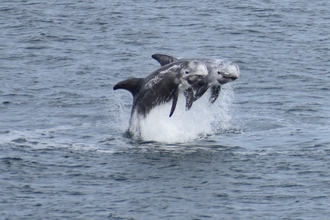Grey seals, Halichoerus grypus, are the larger of the two UK seal species, with the males weighing up to 300kg and females 200kg. Grey seal pups are usually weaned between 17 and 21 days, after gaining as much as 10kg a week feeding on their mothers’ milk, which contains around 50% fat and 12% protein. The weaned pups will live off this fat reserve while they learn to feed themselves, as unlike many other mammal species, their parents don’t teach them what to do! By this time, the pup will also have moulted its white pup fur to reveal its first-year pelage (the name for an animal’s coat of fur).
Grey seals are generally opportunistic feeders. Their diet varies geographically and seasonally, but sand eels and gadids such as cod, whiting and herring are the most important food sources for the UK population. There are three distinct populations of grey seals: in addition to the east Atlantic population, which includes the seals currently pupping around Skomer, the grey seal can also be found off the east coast of North America, from Labrador down to New England, and in another distinct population in the Baltic Sea. There are an estimated 300,000 grey seals globally; the UK population dropped to only 500 in the early 20th century, predominantly due to persecution, but there are now an estimated 120,000 grey seals in the UK – 40% of the global population!








